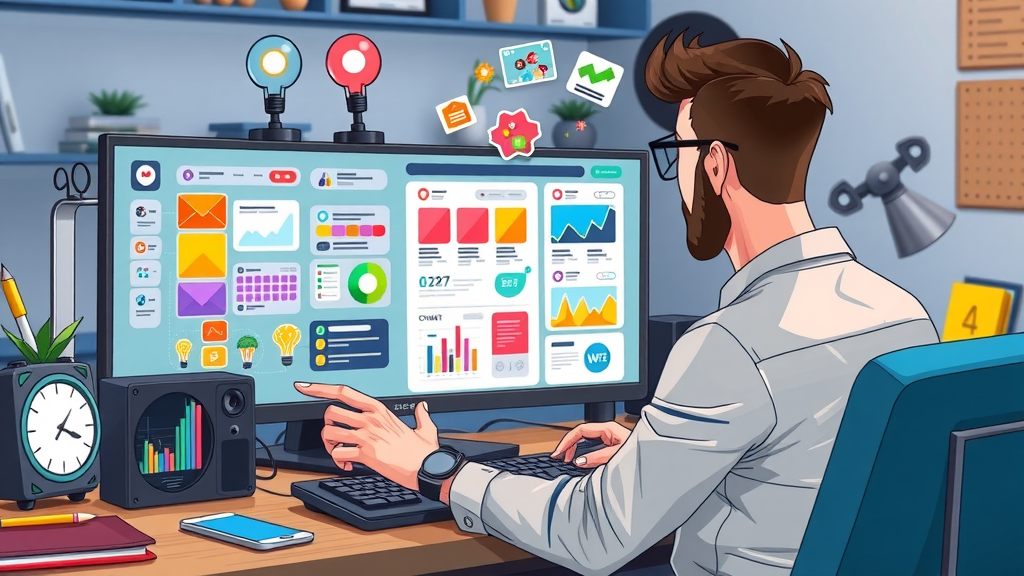Did you know that email marketing delivers an average ROI of 4200%—$42 for every $1 spent ?
That’s not a typo: email remains one of the most powerful digital marketing tools available today, consistently outshining newer channels in nearly every measurable way. If you want to turn casual readers into enthusiastic buyers, mastering the art of email marketing campaigns is absolutely essential.

What You'll Learn
- Why email marketing campaigns are at the heart of successful digital marketing
- What makes an email marketing campaign effective—and profitable
- Step-by-step blueprints: From planning, to automation, to best-in-class content
- Methods to boost deliverability, personalization, and conversions
- How to optimize your marketing campaigns for ongoing success
Why Email Marketing Campaigns Lead the Digital Marketing Charge
The seeming universality of email begs the question: Why are email marketing campaigns so dominant compared to other marketing channels? For starters, unlike social media algorithms that come and go with each trend, email delivers your message directly to your subscriber's inbox. This controlled access makes it easier to drive sales, build brand awareness , and nurture customer loyalty—even more so than other digital marketing avenues.
What’s more, email campaigns easily outperform other platforms when analyzed for open rates, click-throughs, and ROI . A promotional email or series of emails, when sent to the right target audience, can bring in instant website traffic, boost conversions, and spark repeat business. The most successful email marketing campaign doesn’t just inform; it inspires action—helping businesses big and small reach their goals with less spend than ever before.
Email Marketing: Surprising Statistics That Prove Its Power in Modern Campaigns
"Email marketing delivers an average ROI of 4200%—$42 for every $1 spent." — Data & Marketing Association
- How email marketing campaigns outperform other channels
- Key advantages of email campaigns for businesses of all sizes
- The evolving landscape of marketing campaigns and measuring success
The evidence is overwhelming: Not only does email surpass social media’s fleeting reach, but its personalized nature and direct access to your audience’s inbox mean you control the message—and the outcome. Today’s top marketing campaigns still rely on email to establish credibility, sell products, and build communities. As the technology matures, sophisticated features like automation and AI-driven personalization are helping brands set new benchmarks for success.
What Makes an Email Marketing Campaign Successful?
What distinguishes a run-of-the-mill marketing email from a successful email marketing campaign that really converts? First, it's having a clear campaign purpose ; second, ensuring every part of the campaign—from subject line to call to action (CTA)—serves that goal. Third, segmenting your target audience allows you to send the right message to the right person at the right time.
A successful email marketing campaign depends on understanding your audience’s unique needs and behaviors. Businesses that craft good email copy, optimize for readability, and use strong CTAs drive sales and maintain lasting customer relationships. But remember, success is never static. Regularly testing, analyzing, and refining your email marketing strategy is what keeps the best campaigns relevant and profitable in today’s digital marketing world.
Defining the Purpose of Your Email Campaign

Before you craft even a single subject line, pause and clarify: What do you want this email campaign to achieve? Are you aiming to increase brand awareness, announce a special offer with a discount code, or nurture leads through a transactional email series? Maybe your goal is to drive traffic to a new product page or boost engagement for an upcoming event.
Establishing a clear campaign purpose sets the stage for every subsequent decision. This foundation becomes your north star—guiding email copy, design, automation sequences, and ultimately your measurement of success. Defining solid objectives early ensures that your marketing efforts stay focused and effective from the first send to the last follow-up.
How to Identify and Segment Your Target Audience
It’s not enough to send emails; you have to ensure the message arrives with the right recipient. Effective segmentation starts by analyzing your subscriber base—considering factors like demographics, past purchase behavior, and engagement with previous email campaigns. Advanced marketers even overlay predictive analytics to anticipate customer needs and personalize content dynamically.
Audience segmentation allows you to deliver the right message at the right time, improving open rates and boosting conversions. You might segment based on location, interests, purchase history, or engagement level. A carefully segmented list turns an average marketing email into a highly-effective email campaign personalized for maximum impact.
Table: Comparison of Key Metrics—Email Marketing Campaigns vs. Social Media Marketing
| Metric | Email Marketing Campaigns | Social Media Marketing |
|---|---|---|
| Average Open Rate | 20-25% | 2-3% |
| Click-Through Rate | 2-5% | 0.5-1% |
| Average ROI | 4200% ($42 per $1 spent) | 250% ($2.50 per $1 spent) |
| Targeting Capabilities | Advanced Segmentation | Limited Targeting |
| Message Lifespan | Anywhere from hours to weeks | Minutes to hours |
The Five T's of Email Marketing for Highly Successful Email Campaigns
"The right subject line can increase your open rate by 50%—never underestimate its power."
All effective email marketing campaigns abide by the Five T’s: Target, Tease, Teach, Test, and Track . Start by targeting the appropriate audience; tease with engaging subject lines and previews; provide value with educational or entertaining content; continually test variations, and track all metrics rigorously for future improvements.
Whether your campaign is promotional, educational, or transactional, mastering these fundamentals means every campaign is optimized for conversions and long-term engagement. Over time, following the Five T’s will turn your email marketing into a consistently high-performing marketing strategy—delivering value to both your business and your subscribers.
Planning Effective Email Marketing Campaigns: The Blueprint for Success
A successful email marketing campaign doesn’t happen by accident. It’s planned—and planned well. The backbone of any effective campaign is clear goal-setting, robust strategy development, and a deep understanding of the types of emails that work best at every stage of the customer journey.
Planning involves mapping each email in your sequence to a specific objective: Is this message designed to build awareness, nurture a lead, or close the sale? Carefully select campaign types—welcome emails, newsletters, promotional emails, or trigger-based campaigns—for the biggest impact. Your planning stage is the blueprint for a marketing campaign that not only achieves results but also stands out in crowded inboxes.
Setting Measurable Goals and KPIs for Your Email Marketing Campaigns
Start by identifying your Key Performance Indicators (KPIs): Common metrics include open rates, click-through rates, conversion rate, and list growth. Setting measurable objectives upfront allows you to track success, optimize ongoing campaigns, and demonstrate ROI to stakeholders. For instance, if your goal is to increase sales, track not only the opens and clicks but actual purchases resulting from your series of emails.
Knowing what you’re measuring for means you can tailor your tactics and analyze real campaign performance. It’s also essential for benchmarking: Comparing results against both your historical averages and industry standards ensures your email marketing campaigns are winning the race.
Crafting a Robust Marketing Strategy with Email at Its Core
Strong marketing strategy places email at the center of the customer experience. This involves integrating email with other digital assets—your website, product pages, and social media channels—to create a seamless journey. Plan your campaign calendar around seasonal events, product launches, and customer behaviors for maximum relevance.
Best-in-class strategies involve automated workflows that nurture leads from the moment they subscribe to the point of sale—personalized, timely, and always value-driven. Remember: Each marketing email should be supported by clear objectives and designed to move the reader closer to your desired outcome, whether that’s a click, a purchase, or increased brand awareness.
Understanding Different Types of Email Campaigns: Newsletters, Promotions, Triggers, and More
- Welcome emails
- Promotional emails
- Trigger-based campaigns
- Newsletter campaigns
- Transactional emails
Each type of email serves a unique purpose: Welcome emails introduce your brand and set expectations; promotional emails leverage urgency and discount codes to increase sales; newsletters build long-term engagement and trust; trigger-based and transactional emails provide timely, relevant experiences. Incorporate a mix of these emails to meet specific goals, reinforce brand messaging, and increase customer lifetime value across your entire marketing campaign.

Creating Compelling Content for Your Marketing Email
Great content is the backbone of every effective email campaign . From an irresistible subject line through engaging email copy and mobile-optimized design, each element is crucial in turning readers into buyers. Let’s break down the core elements of a good email that converts.
Every successful email campaign puts the subscriber’s needs first. That means clear value, minimal jargon, eye-catching visuals, and a compelling CTA in every message. Investing in storytelling, strong design, and real customer benefits in your email copy will have a measurable impact on your open rates, click-throughs—and your bottom line.
Mastering Subject Lines for High-Performing Email Marketing Campaigns
Your subject line is your first (and often only) chance to grab a subscriber’s attention. In a crowded inbox, subject lines that are concise, relevant, and curiosity-driven get the best results. Personalization—such as adding the recipient’s name or making reference to their recent purchase—increases the probability of an open.
Best practices include keeping subject lines under 50 characters for mobile readability, using action-oriented language, and A/B testing different approaches. A great subject line can literally double your open rate, setting the stage for the effectiveness of the rest of your marketing email .
Crafting Email Copy That Boosts Conversions
- Storytelling in email copy
- Including a clear call-to-action
- Optimizing for mobile and readability
The body of your email copy should do three things: Engage, inform, and inspire action. Effective storytelling creates emotional connections, while succinct language and bullet points aid in readability. Every good email includes a clear, compelling CTA—telling readers exactly what to do next (like “Shop Now,” “Download Free Guide,” or “Book Your Spot”).
Always optimize your content for mobile devices—over half of all email opens happen on smartphones. Short paragraphs, scannable formatting, and prominent CTA buttons make your emails actionable wherever your audience reads them.
Design Best Practices for an Effective Email

Good design ensures your message is seen, read, and acted upon. Stick to a clear layout: use a single-column structure, eye-catching headlines, and plenty of white space for easy navigation. High-quality visuals support your message without overwhelming it.
Make your call-to-action stand out through color contrasts, larger fonts, and placement above the scroll. The most effective campaigns use accessible fonts, proper alt text for images, and a logical structure that ensures every element of your marketing email contributes to a seamless subscriber experience.
Deliverability and Optimization in Email Marketing Campaigns
Deliverability is the silent driver behind successful email marketing campaigns—if your emails aren’t reaching inboxes, even the best content can’t have an impact. To ensure this, you need the right technical setup, robust segmentation, personalization, and a culture of ongoing testing and refinement.
Optimization is a never-ending process—continually adjusting send times, subject lines, and content based on data. It’s also about maximizing value: From A/B testing to list hygiene, the world’s best marketers persistently iterate their marketing campaigns for even greater results.
Ensuring Your Campaigns Avoid the Spam Filter
Good email campaigns land in the inbox, not spam. To avoid spam filters, use a reputable email service, clean your list frequently, avoid deceptive subject lines, and limit excessive use of caps, symbols, and promotional language. Always get permission before adding anyone to your list and include a visible unsubscribe link.
Authenticate your sending domain with DKIM and SPF records, and monitor your sender reputation regularly. Balanced email frequency, relevant content, and audience engagement are key factors determining inbox placement—and ultimately, whether your marketing email makes an impact.
Personalization and Segmentation in Successful Email Marketing
Today’s successful email marketing campaign relies on segmentation and personalization to boost engagement and conversions. Personalized greetings, dynamic content blocks, and product recommendations based on user preferences turn generic messages into tailored experiences.
The more relevant your emails, the higher your open rates and click-through rates will be. List segmentation—by demographics, location, purchase history, or engagement—lets you send content your audience truly values. Smart automation tools empower marketers to deliver the right message every time, building long-term loyalty with every campaign.
A/B Testing for Continuous Improvement of Marketing Email Efforts

A/B testing is non-negotiable for any high-performing marketing campaign. Test everything: subject lines, sender names, CTA buttons, images, and even send times. By running experiments and analyzing the results, you’ll discover what resonates best with your audience and incrementally improve every aspect of your campaigns.
Continuous optimization through A/B testing ensures your emails always perform at their peak, giving you the confidence to expand your marketing efforts, increase sales, and deliver more value to your business and subscribers.
Analyzing Email Campaign Performance: Metrics That Matter
To know if your email marketing campaigns are working, you need to track the numbers that matter: Open rates, click-through rates, conversion metrics, and unsubscribe rates. More advanced marketers also watch revenue per email, email sharing/forwarding rates, and audience growth over time.
Measurement isn’t just about patting yourself on the back—it’s about understanding what’s working, identifying opportunities for improvement, and making informed decisions for your marketing strategy going forward.
Open Rates, Click-Through Rates, and Conversion Tracking
The best performance benchmarks start with open rates—are your subject lines and preheaders enticing readers to open the email? Next, measure your click-through rate to see if your copy and CTA motivate further engagement. Finally, track conversions—how many subscribers completed the action you wanted, whether it’s a purchase, signing up for a webinar, or downloading a guide.
By monitoring these KPIs, you can optimize your next campaign for even better results. Use UTM parameters and integrations with analytics tools to ensure accurate attribution, and always analyze both aggregate trends and individual campaign data for actionable insights.
Benchmarking Against Industry Standards
Comparing your results to industry benchmarks helps you understand how your email marketing campaign stacks up. If your open rates, click-throughs, or conversion numbers fall below average, it’s a clear signal to adjust your approach. Overperforming against benchmarks? Use this momentum to double down on your best strategies.
Regular benchmarking not only provides context for your results but also helps identify opportunities to test new tactics—ensuring you’re never standing still with your email marketing efforts.
Table: Email Marketing Campaign Benchmarks by Industry
| Industry | Average Open Rate | Click-Through Rate | Unsubscribe Rate |
|---|---|---|---|
| E-commerce | 16.8% | 2.0% | 0.12% |
| Business & Finance | 20.5% | 2.9% | 0.10% |
| Nonprofit | 25.2% | 3.1% | 0.09% |
| Technology | 19.0% | 2.4% | 0.11% |
| Retail | 17.1% | 2.2% | 0.13% |
Integrating Email Marketing Campaigns with Broader Marketing Campaigns
Your email marketing campaigns shouldn’t operate in a bubble. Integrating email with other marketing channels—especially social media—can amplify reach and boost results. Combining efforts creates consistent customer experiences and multiple opportunities for engagement and sales.
Whether you’re launching a product, running a promotion, or announcing an event, a unified strategy across email, website, and social media maximizes touchpoints—and gives your marketing efforts the highest chance of success.
Combining Email Marketing with Social Media Strategies

When email and social media combine, the results can be magic. Share your social media posts and profiles in your emails, and encourage subscribers to spread the word. Similarly, promote your email sign-up through your social platforms with lead magnets and gated content.
This integration boosts engagement, expands your reach, and helps reinforce a unified brand voice across every marketing campaign. Cross-channel synergy drives deeper connections and ensures no potential lead falls through the cracks.
Leveraging Data from Multiple Channels to Enhance Marketing Campaign Impact
"The synergy of integrated marketing campaigns multiplies results—email works best when it’s not alone."
By bringing together data from email, social media, website analytics, and CRM systems, you build a 360-degree view of your customers. This holistic perspective lets you personalize messages, forecast buying behaviors, and trigger tailored automation flows for each segment.
The more data you can harness, the smarter and more impactful your email marketing campaign will become. Integrated campaigns are proven to deliver higher open rates, better customer experiences, and—ultimately—greater sales.
Advanced Tactics for Successful Email Marketing Campaigns
To truly excel, look beyond the basics and employ advanced marketing automation , dynamic content, and AI-driven optimizations in your email marketing strategy. These tactics save time, increase personalization, and optimize campaign performance at scale.
Explore the following strategies to edge out your competition and deliver richer, more results-driven email marketing campaigns.
Automation Workflows: Save Time, Boost Results
Automated workflows send personalized emails in response to user behaviors—such as signing up, making a purchase, or abandoning a cart. These series of emails ensure timely, relevant communications without manual effort, increasing revenue and customer satisfaction across the board.
Drip campaigns, event reminders, and re-engagement emails are a must for every modern email marketing strategy. Once set up, they work tirelessly in the background—making your marketing efforts seamless and efficient.
Dynamic Content and Real-Time Personalization
Dynamic content modules let you display personalized offers, product recommendations, or location-based news directly within the email—instantly improving relevance and click-through rates. Real-time elements, like countdown timers or live inventory alerts, create urgency and compel immediate action.
With the right tools, even non-technical marketers can add sophisticated personalization to every campaign, building loyalty and driving repeat sales through one-to-one marketing emails.

Using AI and Predictive Analytics to Refine Email Campaigns
AI-powered tools analyze customer data points to refine send times, subject lines, and offers. Predictive analytics help identify likely buyers, segment your list more effectively, and optimize campaigns for maximum conversions.
From smart content recommendations to automated AB testing, these emerging technologies future-proof your email campaigns—helping you adapt to changing behaviors and market trends while outperforming manual competitors.
Legal, Ethical, and Compliance Considerations in Email Campaigns
Trust is the foundation of email marketing. Staying compliant with laws like GDPR and CAN-SPAM is both a legal obligation and a business best practice. Transparent communication and giving subscribers control over their preferences help maintain trust and long-term engagement.
Above all, ensure every marketing email upholds privacy, consent, and ethical standards—because brands that respect their audience build lasting success.
Understanding GDPR, CAN-SPAM, and Other Email Laws
To avoid penalties, always get explicit permission before sending any marketing email. Provide clear opt-in language during sign-up, identify your business clearly, and include an unsubscribe link in every email.
Stay up to date on email laws in all markets where you operate, and train your team to treat subscriber data as a privilege, not a right. Legal compliance protects both your business and your reputation.
Building Trust through Transparency and Unsubscribe Options
A visible unsubscribe link isn’t just a legal requirement—it’s key to building trust with your audience. Give subscribers simple, hassle-free ways to change preferences or leave your list, and always notify them of significant changes to your privacy policy or communication schedule.
Transparent communication, consistent value delivery, and respect for user choice lay the groundwork for consistently effective—and compliant—email marketing campaigns.
People Also Ask: What are Email Marketing Campaigns?
Explained: The Core Elements of Successful Email Marketing Campaigns
An email marketing campaign is a coordinated series of messages sent to a targeted audience with a specific business goal—whether it’s promoting a product, building brand awareness, or nurturing leads. Each campaign typically includes curated content, thoughtfully designed emails, and measurable CTAs that encourage recipients to act.
Core elements include audience segmentation, enticing subject lines, relevant content, strong CTAs, and continuous optimization based on analytics. All these factors work together to achieve the dual purpose of driving sales and building lasting customer relationships.
People Also Ask: What is the Best Email Marketing Campaign?
Real-World Examples of High-Impact Email Campaigns
The most effective email marketing campaigns are those that match audience needs with timely, valuable offers. Examples include a welcome email series for new subscribers introducing your brand, a promotional email with exclusive discounts for frequent shoppers, or a triggered re-engagement campaign for lapsed customers.
For instance, a leading e-commerce brand might use abandoned cart emails with limited-time discount codes to draw customers back, while a nonprofit could run a storytelling newsletter campaign to boost engagement and donations. Top-performing campaigns always combine smart segmentation, irresistible subject lines, and highly relevant content.
People Also Ask: How Much is a 1000 Email List Worth?
Assessing and Maximizing the Value of Your Email List
A list of 1,000 engaged subscribers can be worth anywhere from a few hundred to several thousand dollars per year, depending on your industry, offers, and frequency of marketing campaigns. The real value comes from an actively engaged, well-segmented list rather than sheer size.
Maximize your list’s value through regular list cleaning, segmentation, and delivering consistent, high-value marketing emails. The more targeted and engaged your audience, the greater your ability to drive sales, improve open rates, and fuel the success of all your digital marketing efforts.
People Also Ask: What are the 5 T's of Email Marketing?
Applying the 5 T’s to Create Successful Email Marketing Campaigns
Successfully applying the Five T’s—Target, Tease, Teach, Test, and Track—means: Target the right segment, tease with compelling subject lines, teach with valuable content, test variations, and track results religiously.
Brands that adhere to these principles see higher engagement and conversion rates, as every marketing campaign is purpose-built to deliver the right message, in the right way, to the right person, at the right time.
Troubleshooting and Improving Underperforming Email Campaigns
Even the best marketers encounter campaign hiccups. Whether open rates are dipping or conversions have plateaued, strategic troubleshooting can revive flagging email campaigns and set you up for ongoing improvement.
Frequent issues stem from weak subject lines, poor segmentation, or a lack of clear CTAs—but these can be fixed quickly with data-driven tweaks and a willingness to test new approaches.
Why Your Email Marketing Campaign May Not Be Converting
If your emails aren’t converting, start by examining your core elements: Are your subject lines too generic? Is your content delivering clear value? Are you sending to the right segment? Often, low performance comes from misaligned messages, oversaturated lists, or lack of actionable next steps.
Review your analytics to identify where subscribers drop off and test new copy, designs, or offers to address pain points quickly and effectively.
Quick Fixes for Low-Performing Subject Lines and Email Copy
- Review segmentation and personalization
- Optimize timing and send frequency
- Test alternative designs and layouts
Sometimes, a simple fix makes all the difference: Try A/B testing subject lines with power words or first names, switch up your CTA button color, or streamline email design for quicker load times. Remember, small tweaks to your email copy can yield big improvements in open rates and conversions.
Best Tools and Platforms for Streamlined Email Marketing Campaigns
Choosing the right email marketing platform is critical for scaling your efforts and optimizing campaign effectiveness. Industry leaders like Mailchimp, Hubspot, ActiveCampaign, and Klaviyo offer robust features for automation, segmentation, analytics, and integrations with CRM and e-commerce solutions.
Evaluate each tool based on business size, campaign volume, feature depth, and integration capabilities to find the perfect fit. Picking the right platform ensures your marketing campaigns remain efficient, high-performing, and easy to manage—even as your business grows.
Top Picks for Email Marketing Platforms by Business Size and Industry

For small businesses or startups, Mailchimp and Constant Contact offer easy onboarding and plenty of templates. Mid-size or scaling companies often prefer Hubspot or ActiveCampaign for advanced CRM features and sophisticated automation. Large enterprises with complex needs gravitate to Marketo or Salesforce Marketing Cloud, which provide deep customization and enterprise-grade integrations.
Nonprofits love platforms with discounted rates and storytelling capabilities, like MailerLite and Campaign Monitor. Make your choice based on the specific goals and technical needs of your campaigns for the smoothest results.
Integrations that Elevate Your Email Campaign Effectiveness
Strong integrations with e-commerce platforms (like Shopify and WooCommerce), CRMs (Salesforce, Zoho), analytics (Google Analytics), and social media tools supercharge your email marketing strategy . These integrations help automate tasks, sync customer data, and enable real-time segmentation and reporting.
The right tech stack lets you build sophisticated workflows, trigger personalized campaigns, and measure every step of the customer journey for superior ROI.
Table: Feature Comparison of Leading Email Marketing Platforms
| Platform | Ease of Use | Automation | Segmentation | Integrations | Best For |
|---|---|---|---|---|---|
| Mailchimp | Beginner-friendly | Good | Robust | Wide Range | SMBs, Nonprofits |
| HubSpot | Moderate | Excellent | Advanced | CRM, Sales | Growing Companies |
| ActiveCampaign | Moderate | Excellent | Advanced | E-commerce, CRM | SMBs, B2Bs |
| Klaviyo | Moderate | Good | Excellent | Shopify, E-commerce | E-commerce |
| Salesforce MC | Challenging | Enterprise-level | Enterprise-level | Deep Integrations | Large Enterprises |
Case Studies: Successful Email Marketing Campaigns Across Industries
E-commerce: Driving Sales with Targeted Email Campaigns
E-commerce brands harness the power of personalized promotions, abandoned cart reminders, and loyalty incentive emails to drive conversions and ramp up sales. Dynamic product recommendations and exclusive discount codes keep customers coming back for more, delivering measurable boosts to both open and click-through rates.
B2B Businesses: Nurturing Leads with Effective Email Campaigns
For B2Bs, email is a critical channel for lead nurturing. A mix of educational content, webinar invites, and case studies turns cold leads into warm prospects. Automated sequencing keeps deals moving down the funnel—building trust with every marketing touchpoint, and ensuring no opportunity goes untapped.
Nonprofits: Engaging Communities Through Compelling Campaigns
Nonprofits use email campaigns to deepen donor relationships, increase event participation, and update supporters on mission progress. Storytelling newsletters, impact reports, and targeted donation campaigns help maximize engagement and community support—all through transparent, human-centered communication.
Quotes from Industry Leaders on Email Marketing Campaign Success
"A great email marketing campaign creates value for both sender and recipient."
Frequently Asked Questions about Email Marketing Campaigns
-
How often should I send email marketing campaigns?
A good rule of thumb is to email at least once a month to stay top of mind, but no more than once a week unless your audience has opted in for frequent updates. Monitor engagement to find your ideal cadence. -
What’s the best time to send a marketing email?
Studies often show that midweek mornings (Tuesday–Thursday, 9–11am) deliver the highest open rates, but test with your own list for the best results. -
Can small businesses compete with big brands through email campaigns?
Absolutely! Small businesses can build deeper relationships and deliver more relevant content because of their closer connection with their audience. Segmentation and personalization even the playing field. -
How do I get more subscribers on my email list?
Use lead magnets like free downloads, discounts, or exclusive content, and promote your sign-up offers across your website and social media. Make the value of joining your list clear from the start.
Core Takeaways for Building Email Marketing Campaigns That Convert
- Define your campaign goal and target audience upfront
- Focus on crafting irresistible subject lines and value-driven content
- Personalize and segment every email campaign
- Continuously analyze results and optimize for performance
Ready to Launch High-Converting Email Marketing Campaigns?
We help businesses like yours get real results. Are you next? Call 772-349-1529
Marketing that moves the needle—book your discovery call today. 772-349-1529
Tired of being invisible online? Let’s fix that—book a free consult. 772-349-1529
Conclusion
Ready to amplify results? Define your goals, deliver value with every send, personalize relentlessly, and never stop optimizing. Start building email marketing campaigns that turn readers into buyers today.
 Add Row
Add Row  Add
Add 



Write A Comment